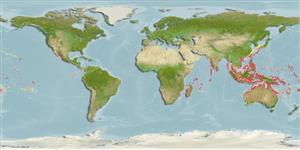Common names from other countries
>
Eupercaria/misc (Various families in series Eupercaria) >
Scaridae (Parrotfishes) > Scarinae
Etymology: Scarus: Greek, skaros = a fish described by anciente writers as a parrot fish; 1601 (Ref. 45335).
More on author: Bleeker.
Environment: milieu / climate zone / depth range / distribution range
Ecologia
marinhas associadas(os) a recifes; intervalo de profundidade 2 - 25 m (Ref. 37816). Tropical
Indo-Pacific: widespread in the Indian Ocean (Ref. 9793), ranging from East Africa south to Natal, South Africa (Ref. 5490) and east to Madagascar, Seychelles, Mauritius, Chagos Archipelago, and Maldives through the eastern Indian Ocean to French Polynesia and Pitcairn. Replaced by Scarus forsteni in most of the Pacific, with overlapping distributions in the Philippines, eastern Indonesia and Palau (Ref. 37816). Recently reported from Tonga (Ref. 53797).
Tamanho / Peso / Idade
Maturity: Lm ? range ? - ? cm
Max length : 52.7 cm TL macho/indeterminado; (Ref. 125599); common length : 17.5 cm SL macho/indeterminado; (Ref. 9793); peso máx. publicado: 2.9 kg (Ref. 125599)
Descrição suscinta
Chaves de identificação | Morfologia | Morfometria
Espinhos dorsais (total) : 9; Raios dorsais (total) : 10; Espinhos anais: 3; Raios anais : 9. Males differ slightly in head pattern and differences most obvious in females with yellow or red anal fins (Ref. 48636). Terminal phase similar to S. forsteni, differing primarily by having a yellow inner pectoral axil (Ref. 37816).
Inhabits lagoon and seaward reefs, in areas with dense coral growth (Ref. 9710) up to at least 30 m. Usually solitary, sometimes in groups (Ref. 9710). Feeds on benthic algae (Ref. 3488).
Ciclo de vida ou comportamento de acasalamento
Maturities | Reprodução | Spawnings | Egg(s) | Fecundities | Larvas
Oviparous, distinct pairing during breeding (Ref. 205).
Randall, J.E. and J.H. Choat, 1980. Two new parrotfishes of the genus Scarus from the Central and South Pacific, with further examples of sexual dichromatism. Zool. J. Linn. Soc. 70:383-419. (Ref. 2689)
Status na Lista Vermelha da UICN (Ref. 130435)
CITES (Ref. 128078)
Not Evaluated
Ameaça para os humanos
Harmless
Uso pelos humanos
Pescarias: espécies comerciais; Aquário: Espécies comerciais
Ferramentas
Relatórios especiais
Baixar XML
Fontes da internet
Estimates based on models
Preferred temperature (Ref.
115969): 24.9 - 29.3, mean 28.4 (based on 3096 cells).
Índice de diversidade filogenética (Ref.
82804): PD
50 = 0.5000 [Uniqueness, from 0.5 = low to 2.0 = high].
Bayesian length-weight: a=0.01778 (0.01082 - 0.02921), b=3.06 (2.93 - 3.19), in cm Total Length, based on LWR estimates for this species & Genus-body shape (Ref.
93245).
Nível Trófico (Ref.
69278): 2.0 ±0.0 se; based on diet studies.
Resiliência (Ref.
120179): médio(a), tempo mínimo de duplicação da população 1,4 - 4,4 anos (Preliminary K or Fecundity.).
Fishing Vulnerability (Ref.
59153): Moderate vulnerability (41 of 100).
